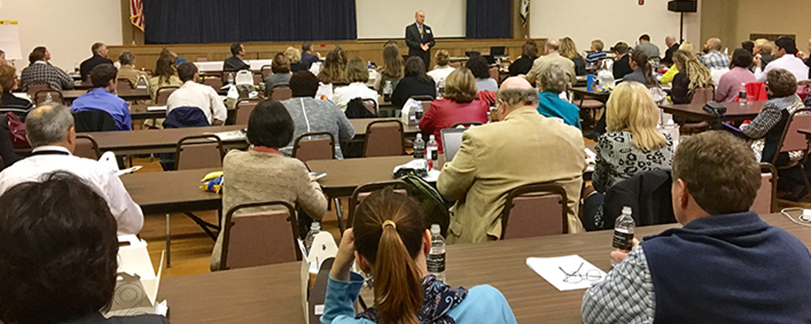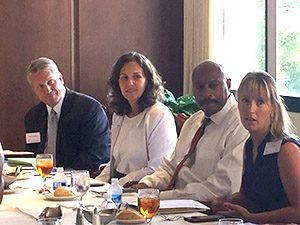WCH In the News
Germinating New Health Cross-Sector Collaborations
Original article courtesy of Build Healthy Places Network
by Jacob Kraybill
April 13, 2017
As part of the Healthy Communities Initiative blog series, we highlight the role of regional Federal Reserve Banks in supporting and enabling cross-sector collaboration across the community development and health sectors. Here we discuss the new and ongoing collaborations popping up in the Federal Reserve Bank of Richmond’s District.
We talked with Jeanne Milliken Bonds, Regional Community Development Team Leader, at the Federal Reserve Bank of Richmond.
Where does the Federal Reserve Bank of Richmond operate and what issues are you focusing on?

Jeanne Milliken Bonds
Regional Community Development Team Leader
The Federal Reserve Bank of Richmond covers Washington D.C., Maryland, North Carolina, South Carolina, Virginia, and most of West Virginia. With such a diverse set of states and geographical regions in our District, we focus on both rural and urban issues. Although the contexts may differ, many of the community development efforts in our District share similar goals: addressing intergenerational poverty, developing and improving affordable housing, and increasing accessibility to nutritious and affordable food, to name a few.
Our District has fast growing urban areas, including cities in North and South Carolina, Virginia and Washington D.C., where there has been a dramatic increase in the cost of housing, leaving low- and moderate-income communities scrambling for affordable housing near needed services. Cities in the Fifth District face other challenges, including civic unrest in Baltimore and Charlotte that captured national attention. These events have prompted renewed and improved conversations around economic opportunities in communities that have long faced structural barriers to advancement.
In the rural areas in our District, including Appalachia, which stretches through western Maryland to South Carolina, and the eastern coastal plain which encompasses part of the “Crescent” that stretches from Virginia to Mississippi, poverty levels are high, access to adequate health care is challenging, and pervasive addiction issues, including opioids and prescription medicine, continue to inhibit opportunities and good health for residents.
Even with these challenges, we are doing significant work in our Reserve Bank through convenings on key issues to bring communities together to find solutions, through applied research and data collection to inform policy leaders, and a focus on emerging issues.
What kind of cross-sector community development or health initiatives are taking place in your District?
In December in West Virginia, we held a conference that highlighted the growing connections between public health and the community development field across the state. Hosted by West Virginia University Health Sciences School, several regional foundations, and our Bank, the event brought together public health practitioners, community development professionals, local officials and officials from the offices of West Virginia Senators Shelley Moore Capito and Joe Manchin, and Congressman Alex Moody to learn and discuss the transformation of neighborhoods and improved understanding of the key social determinants of health.

Attendees in West Virginia
In South Carolina, a program funded by the Robert Wood Johnson Foundation teamed up with the South Carolina Association for Community Economic Development Organizations so local communities could receive funding for healthy communities initiatives. And, in North Carolina we initiated cross-sector conversations with financial institutions, public health departments, health systems and hospitals about data sharing in the creation of data dashboards that link physical and financial health for each of the one hundred counties.
What will future North Carolina meetings focus on?
In North Carolina, public health departments have a mandate to conduct community assessments on a county level. For many of the departments across the state, it is difficult to secure sufficient funding to monitor all of the changes in the communities, and so partnerships have emerged organically between the departments and local health care systems and hospitals.

Discussion in North Carolina in 2016
Later this year, we hope to build on our initial conversation in Charlotte in August 2016 to create regional partnerships between the stakeholders and engage conversations about sharing data and teamwork at the program level.
The goal is to form collaborative groups at the county level, who will build off the data to create local action plans. I’m optimistic that these conversations will lead to meaningful new relationships that can have impact on the communities in our District that need the most help.
What challenges and opportunities do you encounter in your work?
Our District is very populous and diverse, which means that we need to strategically focus our efforts. We juggle many requests to engage on a plethora of issues crucial to community development. The rural areas in our District most challenged by organizational capacity require a special subset of skills that don’t necessarily translate to the same needs of our urban areas. Because of this, we thoughtfully and methodically allocate our time across all regions, choosing projects that we can replicate in other areas.
I’m very enthusiastic about the continued emergence of new partnerships and the cross-sector engagements germinating throughout our District. A Federal Reserve Bank’s role as a convener continues to be relevant and needed. Our work with community partners to address the economic challenges and opportunities in low- and moderate-income communities in the Fifth District, generates a balanced focus in our four core areas: People, Place, Small Business, and Policy and Practice.
The relationship between economic well-being and physical and mental well-being is an interconnected one. We know from our work to look deeply into economic mobility challenges in Charlotte and Baltimore that a child’s address is a powerful predictor of their future well-being. We are committed to engaging the leading practices in our field and applying those practices to the challenges we encounter in order to build new opportunities for people and communities.
Other News
When you can’t afford the cost of life: Redefining poverty’s parameters
WCH In the NewsWhen you can't afford the cost of life: Redefining poverty's parameters Original article courtesy of The News & Observer.May 8, 2022. Lars Dolder, Staff Writer. When Cherrelle Ramsey moved last year into an aging apartment near downtown Cary,...
Analysis: Addressing Our Rural Childcare Crisis
The pandemic has underscored the relationship between our childcare systems and our nation’s economic and social health. A North Carolina project looks at how we need to improve.
NC must leverage American Rescue Plan funds to boost minority-owned, veteran businesses
Appropriations in the current state budget combined with federal dollars from the American Rescue Plan afford North Carolina leaders a propitious opportunity to simultaneously create a more inclusive business ecosystem and address some of the state’s most pressing social, economic, environmental and health equity issues.




